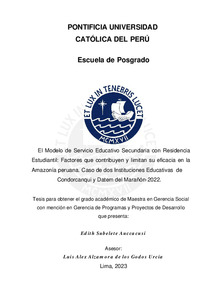| dc.contributor.advisor | Alzamora de los Godos Urcia, Luis Alex | |
| dc.contributor.author | Subelete Auccacusi, Edith | |
| dc.date.accessioned | 2023-10-25T22:20:09Z | |
| dc.date.available | 2023-10-25T22:20:09Z | |
| dc.date.created | 2023 | |
| dc.date.issued | 2023-10-25 | |
| dc.identifier.uri | http://hdl.handle.net/20.500.12404/26239 | |
| dc.description.abstract | La investigación “El Modelo de Servicio Educativo Secundaria con Residencia Estudiantil: Factores que contribuyen y limitan su eficacia en la Amazonía peruana. Caso de dos Instituciones Educativas de Condorcanqui y Datem del Marañón-2022”, tuvo como objetivo identificar los factores que contribuyen y limitan la eficacia del Modelo de Servicio Educativo Secundaria con Residencia Estudiantil (MSE-SRE) a fin de contribuir en la formación holística de los estudiantes para promover su desarrollo a nivel del plano personal, familiar y comunitario. La población de estudio fueron dos comunidades educativas con dicho modelo, ubicadas en la región de Loreto y Amazonas respectivamente, a las cuales se les aplicó entrevistas semiestructuradas y se realizaron focus group.
Entre los resultados destaca que el MSE-SRE logra que el estudiante termine sus estudios de nivel secundario, sin embargo, las condiciones de los dos servicios tanto el educativo y bienestar, presentan carencias a nivel de logística, infraestructura, falta de materiales e insumos básicos en las aulas y vivienda de los residentes, por lo que la dirección debe de autogestionar los recursos.
Por otro lado, el modelo promueve la educación intercultural bilingüe a fin de salvaguardar las lenguas indígenas u originarias de los estudiantes, además permiten esclarecer los puentes con las casas de estudios superiores técnicos o universitarios por medio de las becas brindadas a estudiantes de la zona. Finalmente, al concluir los estudios en la residencia algunos de los egresados retornan a diferentes instituciones de la región a laborar incluyendo las mismas instituciones, ya convertidos en profesionales | es_ES |
| dc.description.abstract | The research "The Secondary Educational Service Model with Student Residence: Factors that contribute and limit its effectiveness in the Peruvian Amazon. Case of two Educational Institutions of Condorcanqui and Datem del Marañón-2022", aimed to identify the factors that contribute and limit the effectiveness of the Secondary Educational Service Model with Student Residence (MSE-SRE) in order to contribute to the holistic training of students to promote their development at the personal, family and community levels. The study population were two educational communities with said model, located in the Loreto and Amazonas regions respectively, to which semi-structured interviews were applied and focus groups were carried out.
Among the results, it stands out that the MSE-SRE achieves that the student completes his secondary level studies, however, the conditions of the two services, both educational and welfare, present deficiencies at the level of logistics, infrastructure, lack of materials and basic supplies. in the classrooms and homes of the residents, so the management must self-manage the resources.
On the other hand, the model promotes bilingual intercultural education in order to safeguard the indigenous or native languages of the students, in addition to clarifying the bridges with the houses of higher technical or university studies through the scholarships provided to students in the area. Finally, at the end of the studies in the residence, some of the graduates return to different institutions in the region to work, including the same institutions, already converted into professionals | es_ES |
| dc.language.iso | spa | es_ES |
| dc.publisher | Pontificia Universidad Católica del Perú | es_ES |
| dc.rights | info:eu-repo/semantics/openAccess | es_ES |
| dc.rights.uri | http://creativecommons.org/licenses/by-nc-sa/2.5/pe/ | * |
| dc.subject | Educación secundaria--Perú | es_ES |
| dc.subject | Planificación educativa | es_ES |
| dc.subject | Cambio educativo | es_ES |
| dc.subject | Construcciones escolares--Perú | es_ES |
| dc.title | El Modelo de Servicio Educativo Secundaria con Residencia Estudiantil: Factores que contribuyen y limitan su eficacia en la Amazonía peruana. Caso de dos Instituciones Educativas de Condorcanqui y Datem del Marañón-2022 | es_ES |
| dc.type | info:eu-repo/semantics/masterThesis | es_ES |
| thesis.degree.name | Maestro en Gerencia Social con mención en Gerencia de Programas y Proyectos de Desarrollo | es_ES |
| thesis.degree.level | Maestría | es_ES |
| thesis.degree.grantor | Pontificia Universidad Católica del Perú. Escuela de Posgrado | es_ES |
| thesis.degree.discipline | Gerencia Social con mención en Gerencia de Programas y Proyectos de Desarrollo | es_ES |
| renati.advisor.dni | 18133490 | |
| renati.advisor.orcid | https://orcid.org/0000-0003-1315-102X | es_ES |
| renati.author.dni | 46106519 | |
| renati.discipline | 314397 | es_ES |
| renati.juror | Torres Hidalgo, Carlos | es_ES |
| renati.juror | Inocente Osorio, Seville | es_ES |
| renati.level | https://purl.org/pe-repo/renati/level#maestro | es_ES |
| renati.type | https://purl.org/pe-repo/renati/type#tesis | es_ES |
| dc.publisher.country | PE | es_ES |
| dc.subject.ocde | https://purl.org/pe-repo/ocde/ford#5.03.01 | es_ES |







